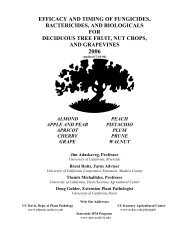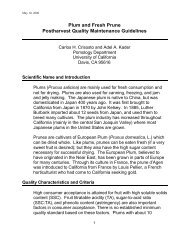Persimmon Postharvest Quality Maintenance Guidelines Carlos H ...
Persimmon Postharvest Quality Maintenance Guidelines Carlos H ...
Persimmon Postharvest Quality Maintenance Guidelines Carlos H ...
Create successful ePaper yourself
Turn your PDF publications into a flip-book with our unique Google optimized e-Paper software.
<strong>Persimmon</strong> 8/27/99<br />
<strong>Postharvest</strong> <strong>Quality</strong> <strong>Maintenance</strong> <strong>Guidelines</strong><br />
<strong>Carlos</strong> H. Crisosto<br />
Pomology Department<br />
University of California<br />
Davis, CA 95616<br />
Scientific Name and Introduction<br />
<strong>Persimmon</strong> is usually the fruit of the species Diospyros kaki, a tree<br />
belonging to the family Ebenaceae and native to the Far East. It was<br />
originally cultivated in China and Japan, and it is therefore also known<br />
as the CHINESE DATE PLUM. Today persimmon is cultivated throughout the<br />
warmer parts of the world, e.g., in the South of France and other<br />
Mediterranean countries, as well as in the USA.<br />
The fruit is a berry resembling a tomato in color, shape and size, but the<br />
seeds are large, almond-shaped and few in number. The epidermis is<br />
thin, as in the tomato, and an enlarged calyx adheres to the base of the<br />
fruit. <strong>Persimmon</strong> has a delicious flavor and may be eaten as a dessert<br />
fruit, or it may be consumed dried or candied. In the USA a native<br />
species, Diospyros virginiana, occurs, but its fruit is very inferior to D.<br />
kaki. Another well known species is D. lotus, yielding DATE PLUMS and<br />
cultivated in the Orient and Italy.<br />
<strong>Quality</strong> Characteristics and Criteria<br />
Skin color from yellow to orange color with medium to large in size. Fruit<br />
should be firm (penetration force, using an 8-mm tip). It is suggested<br />
above 5 lb-force for 'Fuyu' and similar cultivars. Fruit should be freedom<br />
from growth cracks, mechanical injuries and decay. Soluble solids of<br />
21-23% in 'Hachiya' and 18-20% in 'Fuyu' and similar non-astringent<br />
cultivars are recommended with no astringency (tannin content). Fruit is<br />
a good source of carotenoids, vitamin A, vitamin C, and dietary fiber.
Horticultural Maturity Indices<br />
Minimum maturity is based on skin color change from green to orange, or<br />
reddish-orange ('Hachiya') or to yellowish-green or yellow ('Fuyu,'<br />
'California Fuyu,' 'Jiro'). 'Hachiya': Blossom end's color is orange or<br />
reddish color equal to or darker than Munsell color chart 6.7 YR-5.93/12.7<br />
on at least 1/3 of the fruit's length with the remaining 2/3 a green color<br />
equal to or lighter than Munsell color 2.5 GY-5/6. Other varieties: Attained<br />
a yellowish-green color equal to or lighter than Munsell color chart 10Y-6/6.<br />
Grades, Sizes and Packaging<br />
The best method of harvesting the fruit is to clip it with small secateurs<br />
from the tree, leaving the calyx attached to the fruit. It is possible to<br />
snap the fruit from the tree but this practice is not recommended, as it<br />
may injure the fruit and adjoining shoot. The fruit must be handled very<br />
carefully to avoid bruising, likely to result in marking which becomes<br />
unsightly as the fruit ripens. Two to three picks are usually required,<br />
depending on fruit size and color, to harvest the crop. Size is especially<br />
important if fruit is to be exported to Japan, where large variations in<br />
price occur between fruit of different sizes. A desirable size for 'Fuyu' is<br />
230-250 g; and 200 g is a minimum marketable size for this cultivar.<br />
Optimum Storage Conditions<br />
Chilling injury: 'Fuyu' and similar non-astringent cultivars are chillingsensitive<br />
at temperatures between 5 O C and 15 O C (41 O F and 59 O F) and<br />
will exhibit flesh browning and softening. Exposure to ethylene<br />
aggravates chilling injury at these temperatures.<br />
Optimum Temperature
0 o C ± 1 o C (32 ± 2 o F). Freezing point: -2 o C (28 o F); may vary depending<br />
on soluble solids content.<br />
Relative humidity<br />
Humidity 90-95% R.H.<br />
Rates of Respiration<br />
2-4 ml CO2 / kg•hr 0ºC (32ºF)<br />
10-12 ml CO2 / kg•hr 20ºC (68ºF)<br />
To calculate heat production multiply ml CO2/kg•hr by 440 to get<br />
Btu/ton/day or by 122 to get kcal/metric ton/day.<br />
Controlled Atmosphere (CA) Considerations<br />
Low oxygen (3-5%) delays ripening.<br />
Carbon dioxide at 5-8% helps retain firmness and can reduce chilling injury<br />
symptoms on 'Fuyu' and similar cultivars.<br />
<strong>Postharvest</strong> life under optimum temperature and relative humidity in<br />
ethylene-free air can be up to 3 months vs. 5 months in optimum, ethylenefree<br />
CA (3-5% O 2 + 5-8% CO 2 ) conditions.<br />
Retail Outlet Display Considerations<br />
Cold table display.<br />
Chilling Sensitivity
It varies according to cultivars. 'Fuyu' is chilling sensitive.<br />
Rates of Ethylene Production and Sensitivity<br />
>0.1 :l/kg•hr at 0ºC (32ºF)<br />
0.1-0.5 :l/kg•hr at 20ºC (68ºF)<br />
<strong>Persimmon</strong>s are very sensitive to ethylene action. Exposure to 1 ppm<br />
and 10 ppm ethylene at 20ºC (68ºF) accelerates softening to less than 4<br />
lb – force (limit of marketability) after 6 and 2 days, respectively. Thus,<br />
ethylene removal and/or exclusion from transport and storage facilities is<br />
highly recommended.<br />
Physiological Disorders<br />
Chilling Injury<br />
Occurrence: The incidence and severity of chilling injury depend<br />
upon the cultivar ('Fuyu' is chilling-sensitive while 'Hachiya' is not<br />
chilling-sensitive), storage temperature and duration.<br />
Symptoms: Chilling injury can be a major cause of deterioration of<br />
'Fuyu' persimmons during marketing after exposure to temperatures<br />
15ºC (59ºF). Symptom development is fastest at 5-7ºC (41-45ºF)<br />
and slowest at 0ºC (32ºF), which is the recommended storage and<br />
transport temperature for persimmons.<br />
Physiology: 'Fuyu' persimmons exhibit chilling injury symptoms if<br />
kept at temperatures between 2ºC (36ºF) and 15ºC (59ºF). Upon<br />
transfer to higher temperatures the severity of the symptoms (flesh<br />
softening, browning, and water-soaked appearance) increases an<br />
renders the fruits unmarketable. Respiration and ethylene<br />
production rates of chilled 'Fuyu' persimmons are higher than those<br />
of nonchilled fruits. Exposure to ethylene at 1 ppm or higher<br />
aggravates chilling symptoms of 'Fuyu' persimmons, while controlled<br />
atmospheres ameliorate these symptoms.
Control: Avoid exposure of 'Fuyu' persimmons to temperatures<br />
between 2ºC (36ºF) and 15ºC (59ºF). Optimum storage and<br />
transport temperature is 0ºC (32ºF). Avoid exposure to ethylene<br />
above 1ppm throughout postharvest handling of 'Fuyu' persimmons.<br />
Use of controlled atmosphere of 3-5% O 2 + 5-8% CO 2 at<br />
temperatures below 5ºC (41ºF) reduced chilling injury.<br />
Disorders induced by low O 2 and/or high CO 2 :<br />
Exposure to oxygen levels below 3% during storage for longer than<br />
one month can result in failure of persimmons to ripen and off flavors.<br />
Exposure to carbon dioxide levels above 10% during storage for<br />
longer than one month can cause brown discoloration of the flesh<br />
and off-flavors.<br />
<strong>Postharvest</strong> Pathology<br />
Alternaria rot is caused by Alternaria alternata which attacks developing<br />
fruits. Infections remain quiescent until after harvest, and black spots<br />
become apparent as the fruits ripen in store. Wound infection results<br />
in earlier appearnace of symtoms.<br />
Other causes of decay in persimmons include species of Botrytis,<br />
Cladosporium, Colletotrichum, Mucor, Penicillium, Phoma and<br />
Rhizopus.<br />
Calyx Separation is a physiological disorder which may affect certain<br />
cultivars; it has caused losses in New Zealand. Growing<br />
conditions are all-important, and excessive nitrogen fertilization<br />
should be avoided. If the plants are thinned early in the season,<br />
this will enhance calyx growth and help to prevent the disorder.
Special Considerations<br />
Removal of Astringency from 'Hachiya' <strong>Persimmon</strong>s: Ethylene (10<br />
ppm) at 20ºC (68ºF) can be used to remove astringency but the excessive<br />
softening that results would make it very difficult to market the persimmons.<br />
Exposure to air enriched with 80% CO2 for 24 hours at 20ºC (68ºF) is<br />
effective in removing astringency while maintaining firmness.<br />
Although persimmons are mainly consumed fresh they can also be frozen,<br />
cooked and made into jam or jelly.<br />
References<br />
Beede, R.H. 1983. The storage performance of the Fuyu persimmon<br />
and its susceptibility to chilling injury. M. Sc. Thesis, Department of<br />
Pomology, University of California, Davis.<br />
Collins, R.J. and J.S. Tisdell. 1995. The influence of storage time and<br />
temperature on chilling injury in Fuyu and Suruga persimmon (Diospyros<br />
khaki L.) grown in subtropical Australia. <strong>Postharvest</strong> Biology &<br />
Technology 6:149-157.<br />
Glucina, P.G. 1987. Calyx separation: a physiological disorder of<br />
persimmons. Orchardist of New Zealand 60:161-163 illus.<br />
Ito, S. 1971. The persimmon. Pp. 281-301, In: Hulme, A.C. (ed.). The<br />
biochemistry of fruits and their products. Acadmic Press, New York, NY.<br />
Ito, S. 1980. <strong>Persimmon</strong>. Pp. 442-468, In: Nagy, S. and P.E. Shaw<br />
(ed.). Tropical and subtropical fruits, compositions, properties and uses.<br />
AVI Publ. Co., Westport, CT.<br />
Kitagawa, H. and P.G. Glucina. 1984. <strong>Persimmon</strong> culture in New<br />
Zealand. N.Z. Dept. Sci. Ind. Res. Info. Ser. No. 159, Chapters 6 and 7.
MacRae, E.A. 1987. Development of chilling injury in New Zealand<br />
grown Fuyu persimmon during storage. N.Z.J. Exp. Agric. 15:333-344.<br />
Prusky, D., R. Ben-Arie and S. Guelfat-Reich. 1981. Etiology and<br />
histology of Alternaria rot of persimmon fruits. Phytopathology 71:1124-<br />
1128.<br />
Snowdon, A.L. 1990. A color atlas of postharvest diseases and<br />
disorders of fruits and vegetables. Volume 1: General introduction and<br />
fruits. CRC Press, Inc. Boca Raton, Florida.<br />
Acknowledgments<br />
Some of the information included was from the University of California -<br />
Davis website on “Fresh Produce Facts” at<br />
http://postharvest.ucdavis.edu/produce/producefacts/






